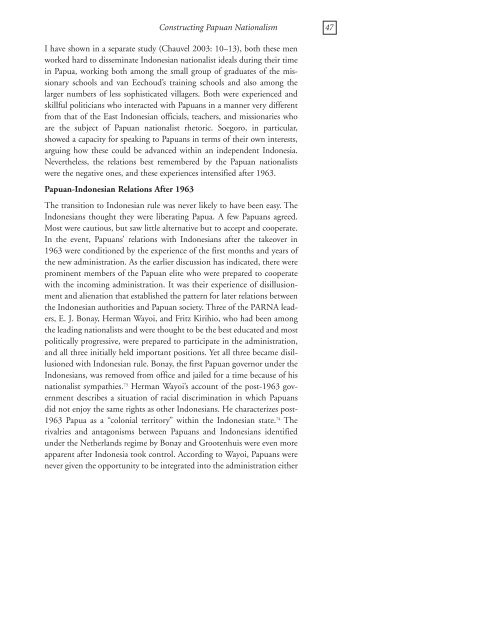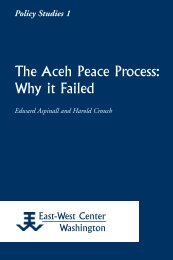Constructing Papuan Nationalism: History, Ethnicity ... - ScholarSpace
Constructing Papuan Nationalism: History, Ethnicity ... - ScholarSpace
Constructing Papuan Nationalism: History, Ethnicity ... - ScholarSpace
- No tags were found...
Create successful ePaper yourself
Turn your PDF publications into a flip-book with our unique Google optimized e-Paper software.
<strong>Constructing</strong> <strong>Papuan</strong> <strong>Nationalism</strong> 47I have shown in a separate study (Chauvel 2003: 10–13), both these menworked hard to disseminate Indonesian nationalist ideals during their timein Papua, working both among the small group of graduates of the missionaryschools and van Eechoud’s training schools and also among thelarger numbers of less sophisticated villagers. Both were experienced andskillful politicians who interacted with <strong>Papuan</strong>s in a manner very differentfrom that of the East Indonesian officials, teachers, and missionaries whoare the subject of <strong>Papuan</strong> nationalist rhetoric. Soegoro, in particular,showed a capacity for speaking to <strong>Papuan</strong>s in terms of their own interests,arguing how these could be advanced within an independent Indonesia.Nevertheless, the relations best remembered by the <strong>Papuan</strong> nationalistswere the negative ones, and these experiences intensified after 1963.<strong>Papuan</strong>-Indonesian Relations After 1963The transition to Indonesian rule was never likely to have been easy. TheIndonesians thought they were liberating Papua. A few <strong>Papuan</strong>s agreed.Most were cautious, but saw little alternative but to accept and cooperate.In the event, <strong>Papuan</strong>s’ relations with Indonesians after the takeover in1963 were conditioned by the experience of the first months and years ofthe new administration. As the earlier discussion has indicated, there wereprominent members of the <strong>Papuan</strong> elite who were prepared to cooperatewith the incoming administration. It was their experience of disillusionmentand alienation that established the pattern for later relations betweenthe Indonesian authorities and <strong>Papuan</strong> society. Three of the PARNA leaders,E. J. Bonay, Herman Wayoi, and Fritz Kirihio, who had been amongthe leading nationalists and were thought to be the best educated and mostpolitically progressive, were prepared to participate in the administration,and all three initially held important positions. Yet all three became disillusionedwith Indonesian rule. Bonay, the first <strong>Papuan</strong> governor under theIndonesians, was removed from office and jailed for a time because of hisnationalist sympathies. 73 Herman Wayoi’s account of the post-1963 governmentdescribes a situation of racial discrimination in which <strong>Papuan</strong>sdid not enjoy the same rights as other Indonesians. He characterizes post-1963 Papua as a “colonial territory” within the Indonesian state. 74 Therivalries and antagonisms between <strong>Papuan</strong>s and Indonesians identifiedunder the Netherlands regime by Bonay and Grootenhuis were even moreapparent after Indonesia took control. According to Wayoi, <strong>Papuan</strong>s werenever given the opportunity to be integrated into the administration either
















